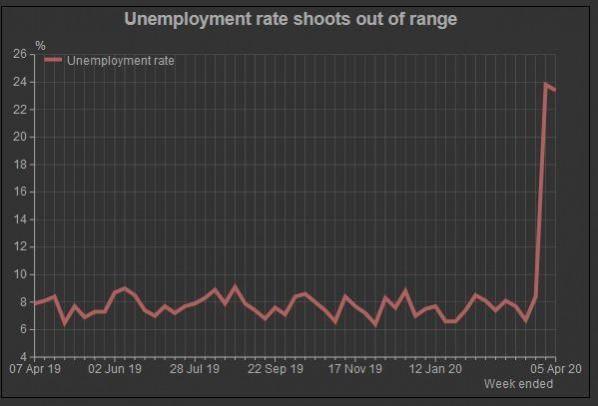With the Covid-19 pandemic plaguing global markets, the unemployment rate in India soars to an all-time high of 8.7 percent in March, worst in the past 43 months. Also, the labour participation rate has fallen by an entire percentage point in the last two months between January to March - from 42.96 per cent in January to 41.90 per cent in March, according to the Centre for Monitoring Indian Economy (CMIE) findings.

The labour statistics for March 2020 are worrisome considering the unemployment rate shot up sharply, while the employment rate in the country nosedived to an all-time low of 38.2 per cent in March 2020, after having struggled to stabilise for the past two years.
LPR at an all-time low, increase in unemployment levels
The labour participation rate (LPR) was 41.9 percent in March 2020, a steep fall from 42.7 per cent in March 2019. The fall gets worse as the nation moves into lockdown even further. This is the first time ever that the LPR has fallen below 42 percent as a result of a sharp 9-million decrease in labour force from 443 million in January 2020 to 434 million in March 2020. The 9 million fall in the labour force comprises a 15 million fall in the count of the employed and a 6 million increase in the count of unemployed, according to CMIE.
The labour force is made up of all employed and unemployed people. The worst fall witnessed owing to the Covid-19 outbreak, with the number of employed persons sliding from 411 million to 396 million, and the unemployed numbers increasing from 32 million to 38 million from January to March 2020.
The unemployment rate largely was under 8 percent from April 2019 till February 2020, except for months of July and October when it crossed above 8 percent. The state of Tripura recorded the highest unemployment rate at 29.9 percent in March 2020, while Puducherry with 1.2 percent registered the lowest unemployment rate, according to CMIE's monthly time series.
The unemployment rate in March was 8.7 per cent, which is the highest in 43 months or since last September 2016. It has risen steadily post demonetisation, with a low point of 3.4 percent in July 2017. The unemployment rate has seen a rather sharp increase from the 7.16 percent level of January 2020.

Also, unemployment has risen sharply over the last two months by 158 basis points, the largest ever-increase over a two month period ever since the coronavirus outbreak, demanding the nationwide shutdown of business activities to disrupt the economic balance further. However, a notable increase in unemployment in March alone by 98 basis points is the largest increase recorded in years, thus far.
This data was derived on the basis of 83,929 observations conducted on a small sample size in March 2020 as per Consumer Pyramids Household Survey. The size of observation is much smaller of a sample then the normally deployed in making monthly estimates usually over 117,000 individuals.
Findings last week reveal, the unemployment rate was 23.8 per cent, with the labour participation rate falling to 39 per cent and the employment rate at a mere 30 per cent.
If this situation continues, what will be the unemployment rate in April?
Those who were employed about a week ago or so, are not employed today because of the nationwide lockdown. So this section of people cannot be classified as unemployed as they are not looking for jobs, and they could get back to their old jobs after the lockdown gets over. This makes the status of their employment rather unclear to the government.
With a reasonable certainty of such people perhaps returning to the old jobs, then the case of such an individual (s) can be classified as employed with or without pay but, with no work. This could be called underemployment or disguised unemployment.

Considering the fact that institutions are not the biggest providers of jobs in India, most employed sections are working in unorganised sectors. According to CMIE, "The unemployment rate in India mostly reflects a mismatch between the demand for jobs among the relatively educated people and the availability of jobs for them typically in modern institutions. It does not reflect correctly, the state of the daily wage workers and the self-employed."
In light of the current crisis, former Reserve Bank of India (RBI) Governor Raghuram Rajan has urged the government to start taking immediate measures for economic revival once the lockdown is lifted. He further suggested the government to "prioritise spending on the poor and reduce or delay less important expenditure."
The RBI should consider imposing a moratorium on financial institution dividend payments to build on the capital reserves and the Central Bank should consider lending only against high-quality collateral to well-managed non-banking financial companies (NBFCs). Also, the government should reach out to experts who possess experience in dealing with the global financial crisis.













